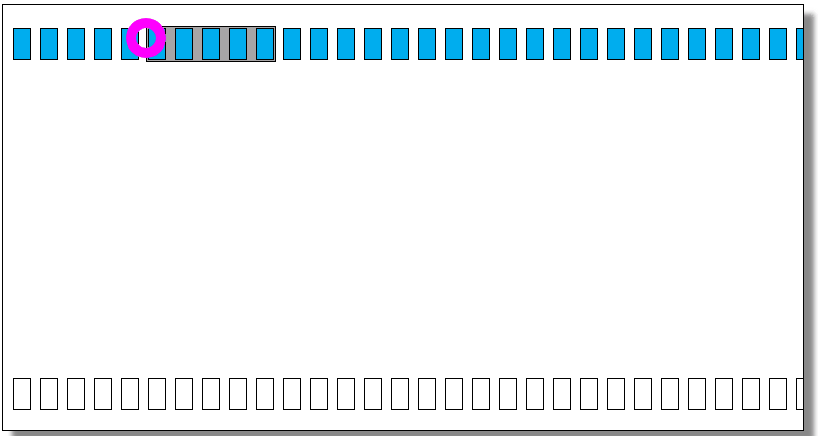0 1 2 3 4
0 1 2 3 4 5 6 7 0 1 2 3 4 5 6 7 0 1 2 3 4 5 6 7 0 1 2 3 4 5 6 7
-+-+-+-+-+-+-+-+-+-+-+-+-+-+-+-+-+-+-+-+-+-+-+-+-+-+-+-+-+-+-+-+- -----------------
| Source Port | Destination Port |
-+-+-+-+-+-+-+-+-+-+-+-+-+-+-+-+-+-+-+-+-+-+-+-+-+-+-+-+-+-+-+-+- UDP header
| Length | Checksum |
-+-+-+-+-+-+-+-+-+-+-+-+-+-+-+-+-+-+-+-+-+-+-+-+-+-+-+-+-+-+-+-+- -----------------
| Sequence Number |
-+-+-+-+-+-+-+-+-+-+-+-+-+-+-+-+-+-+-+-+-+-+-+-+-+-+-+-+-+-+-+-+- Header Reliable UDP emitter
| Checksum |S P F| zeros | 8 bytes
-+-+-+-+-+-+-+-+-+-+-+-+-+-+-+-+-+-+-+-+-+-+-+-+-+-+-+-+-+-+-+-+- -----------------
| payload/data | a payload of maximum 1400 bytes
-+-+-+-+-+-+-+-+-+-+-+-+-+-+-+-+-+-+-+-+-+-+-+-+-+-+-+-+-+-+-+-+- -----------------
The sequence number is a 4 byte number (unsigned int !L) that's part of the added header on UDP from the emitter's side. We chose to set the sequence number as:
- a random number
seq_nr[0]between0and1 << 16for the first packet seq_nr[n+1]=seq_nr[n] + 1 + length of payload sent through the packetTo ensure that the sequence number doesn't get bigger than1<<16we use modulo(1<<16 -1). We chose1<<16 -1and not simply1<<16because we save one sequence number for a specialwindow_0message.
For calculating the checksum, we chose the following algorithm:
def calculeaza_checksum(octeti):
global max_nr # this has value 1<<16
checksum = 0
numere = []
if len(octeti) % 2 == 1: # in case the packet has odd number of octets we add one more
octeti += bytes(1)
for i in range(0, len(octeti), 2): # we form 16 bit numbers from pairs of consecutive octets
numar = octeti[i] << 8
numar += octeti[i+1]
numere.append(numar)
sum=0
for numar in numere:
sum+=numar # we add these numbers to a sum
sum1 = sum % max_nr # to deal with large amounts of numbers, we add the carry
sum2 = sum//max_nr # while adding the numbers
sum = sum1+sum2
checksum = max_nr - 1 - (sum) # checksum is one's complement of this sum
return checksumVerifying this checksum:
def verifica_checksum(octeti):
global max_nr # this has value 1<<16
sum = 0
if len(octeti) % 2 == 1: # in case the packet has odd number of octets we add one more
octeti += bytes(1)
for i in range(0, len(octeti), 2):
numar = octeti[i] << 8 # we form 16 bit numbers from pairs of consecutive octets
numar+=octeti[i+1]
sum+=numar # we add these numbers to a sum
sum1 = sum % max_nr # to deal with large amounts of numbers, we add the carry
sum2 = sum//max_nr # while adding the numbers
sum = sum1+sum2
# by now this sum should be 65535, the largest number on 16 bits
sum+=1 # by adding 1, modulo (1<<16) we should get a 0
sum = sum % max_nr
if(sum==0):
return True
else:
return FalseWe have 3 types of flags available:
- 'S', encoded as 001, which signals that we want to start a connection
- 'P', encoded as 010, that marks packets of the actual data we want to transmit
- 'F', encoded as 100, which signals that we want to stop the connection
0 1 2 3 4
0 1 2 3 4 5 6 7 0 1 2 3 4 5 6 7 0 1 2 3 4 5 6 7 0 1 2 3 4 5 6 7
-+-+-+-+-+-+-+-+-+-+-+-+-+-+-+-+-+-+-+-+-+-+-+-+-+-+-+-+-+-+-+-+- -----------------
| Source Port | Destination Port |
-+-+-+-+-+-+-+-+-+-+-+-+-+-+-+-+-+-+-+-+-+-+-+-+-+-+-+-+-+-+-+-+- UDP header
| Length | Checksum |
-+-+-+-+-+-+-+-+-+-+-+-+-+-+-+-+-+-+-+-+-+-+-+-+-+-+-+-+-+-+-+-+- -----------------
| Acknowledgment Number |
-+-+-+-+-+-+-+-+-+-+-+-+-+-+-+-+-+-+-+-+-+-+-+-+-+-+-+-+-+-+-+-+- Header Reliable UDP receiver
| Checksum | Window | 8 bytes
-+-+-+-+-+-+-+-+-+-+-+-+-+-+-+-+-+-+-+-+-+-+-+-+-+-+-+-+-+-+-+-+- -----------------
The acknowledgment number is a 4 byte number (unsigned int !L). When the receiver receives a package with seq_nr it acknowledges it by sending back a package with an acknowledgment number set to ack_nr = seq_nr + 1. This is how we know which packages were received and which were not. Because the acknowledgment number depends on the sequence number, it must go through the same modulo operations as the sequence number to ensure that it does not overflow 4 bytes.
In a real-world situation, the window would be the receiver's way to tell the emitter how many more packets to send based on the free space in its buffer. We simulate this by sending a random window between 0 and 5 with every packet.
We used the adaptive timeout used in TCP:
SRTT[n+1] = 0.9*SRTT[n] + 0.1*RTT[n+1]Svar[n+1] = 0.9*Svar[n] + 0.1 * abs(RTT[n+1] - SRTT[n+1])timeout[n] = SRTT[n] + 4*Svar[n]
where:
SRTT[n]is the smooth round trip time for packetnSvar[n]is the smooth variation up until packetn
When we receive a window size of 0 we stop sending packets and wait for the receiver to send us another window. In order to avoid stalling, the receiver has a special packet that it sends to the emitter after a window 0 packet. This special packet is mapped with the sequence number 1<<16 - 1, to avoid confusion with an acknowledgment number from an actual packet.

